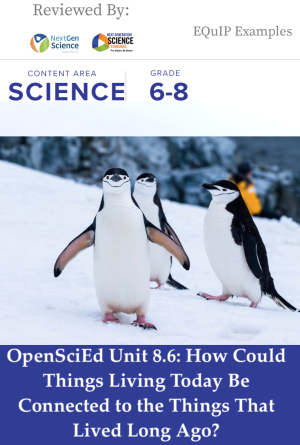
OpenSciEd is a nonprofit organization that brings together educators, philanthropic organizations, curriculum developers, and professional development providers to improve science education through the development and implementation of high-quality, freely available science instructional materials. While this work has begun at the middle school level with Grades 6 through 8, the goal of OpenSciEd is to ensure that all educators, from elementary to high school, have access to a free, coherent, rigorous, research-based set of instructional materials that will support all students in meeting the vision for science literacy described in A Framework for K-12 Science Education and the Next Generation Science Standards.
Score: 9
Awarded the NGSS Design Badge
Science Discipline: Life Science, Earth and Space Science
Length: Unit
Year Reviewed: 2022
This unit begins with students hearing about the surprising fossil of an ancient penguin (nicknamed “Pedro”) in a podcast from the researchers who found and identified the fossil. Students analyze data about modern penguins and develop initial explanations of how these penguins could be connected. They brainstorm about 1) Where did all the ancient penguins go? 2) Where did all the different species of modern penguins come from? and 3) What other organisms alive today might also be connected to organisms that lived long ago?
In the first lesson set, students investigate the connections between organisms living today and those that lived long ago. Students explore heritable traits in modern penguins and examine similar data for ancient penguins. They also analyze data from ancient and modern species of horses, whales, and horseshoe crabs to see whether these organisms have similar patterns. They put together what they have figured out to explain the patterns they uncovered in how organisms change. In the second lesson set, students work on explaining these patterns to develop and use a model of adaptation by natural selection. Students identify common mechanisms that underlie the causes for each of the population changes and develop a model for natural selection that explains all five cases they have been examining.
In the last part of the unit, students extend their model of the cause of trait changes in populations over time to include the mechanisms of mutation and sexual reproduction they developed in the previous unit. Students use their natural selection model to explain how some body structure variations in different species of modern penguins could result from natural selection and how they could descend from a common ancient ancestor penguin population. They analyze embryological data from different stages of development for different species to add to their argument about how different types of living things (species) may be connected. The unit ends with students taking stock of all the questions they answered in this unit and previous OpenSciEd units and identifying questions they look forward to figuring out in high school.
Link to Materials
The following link will direct you to OpenSciEd’s Unit 8.6: How Could Things Living Today Be Connected to the Things That Lived Long Ago?: OpenSciEd Unit 8.6: How Could Things Living Today Be Connected to the Things That Lived Long Ago?
The NGSS Design Badge is awarded only to the version of this unit that was reviewed. If any modifications are made to this unit, the revised version cannot be promoted as having earned the badge.
 Reviews & Questions
Reviews & Questions
No comments submitted